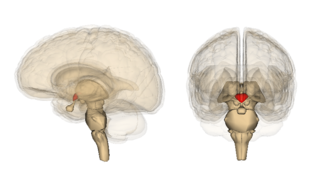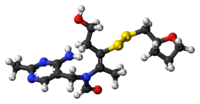
Thiamine, also known as thiamin and vitamin B1, is a vitamin, an essential micronutrient for humans and animals. It is found in food and commercially synthesized to be a dietary supplement or medication. Phosphorylated forms of thiamine are required for some metabolic reactions, including the breakdown of glucose and amino acids.

A vitamin is an organic molecule that are essential to an organism in small quantities for proper metabolic function. Essential nutrients cannot be synthesized in the organism in sufficient quantities for survival, and therefore must be obtained through the diet. For example, Vitamin C can be synthesized by some species but not by others; it is not considered a vitamin in the first instance but is in the second. Most vitamins are not single molecules, but groups of related molecules called vitamers. For example, there are eight vitamers of vitamin E: four tocopherols and four tocotrienols.

Kazimierz Funk, commonly anglicized as Casimir Funk, was a Polish-American biochemist generally credited with being among the first to formulate the concept of vitamins, which he called "vital amines" or "vitamines".

Allicin is an organosulfur compound obtained from garlic, a species in the family Alliaceae. It was first isolated and studied in the laboratory by Chester J. Cavallito and John Hays Bailey in 1944. When fresh garlic is chopped or crushed, the enzyme alliinase converts alliin into allicin, which is responsible for the aroma of fresh garlic. The allicin generated is unstable and quickly changes into a series of other sulfur-containing compounds such as diallyl disulfide. Allicin is part of a defense mechanism against attacks by pests on the garlic plant.
B vitamins are a class of water-soluble vitamins that play important roles in cell metabolism and synthesis of red blood cells. Though these vitamins share similar names (B1, B2, B3, etc.), they are chemically distinct compounds that often coexist in the same foods. In general, dietary supplements containing all eight are referred to as a vitamin B complex. Individual B vitamin supplements are referred to by the specific number or name of each vitamin, such as B1 for thiamine, B2 for riboflavin, and B3 for niacin. Some are more commonly recognized by name than by number, for example pantothenic acid, biotin, and folate.

Wernicke encephalopathy (WE), also Wernicke's encephalopathy, or wet brain is the presence of neurological symptoms caused by biochemical lesions of the central nervous system after exhaustion of B-vitamin reserves, in particular thiamine (vitamin B1). The condition is part of a larger group of thiamine deficiency disorders that includes beriberi, in all its forms, and alcoholic Korsakoff syndrome. When it occurs simultaneously with alcoholic Korsakoff syndrome it is known as Wernicke–Korsakoff syndrome.

Homocystinuria or HCU is an inherited disorder of the metabolism of the amino acid methionine due to a deficiency of cystathionine beta synthase or methionine synthase. It is an inherited autosomal recessive trait, which means a child needs to inherit a copy of the defective gene from both parents to be affected. Symptoms of homocystinuria can also be caused by a deficiency of vitamins B6, B12, or folate.

Thiaminase is an enzyme that metabolizes or breaks down thiamine into two molecular parts. It is an antinutrient when consumed.

Achlorhydria and hypochlorhydria refer to states where the production of hydrochloric acid in gastric secretions of the stomach and other digestive organs is absent or low, respectively. It is associated with various other medical problems.
Derrick Lonsdale is an American pediatrician and researcher into the benefits of certain nutrients in preventing disease and psychotic behavior. He is a Fellow of the American College of Nutrition (FACN), and also a Fellow of the American College for Advancement in Medicine (FACAM)
Toxic and nutritional optic neuropathy is a group of medical disorders defined by visual impairment due to optic nerve damage secondary to a toxic substance and/or nutritional deficiency. The causes of these disorders are various, but they are linked by shared signs and symptoms, which this article will describe. In several of these disorders, both toxic and nutritional factors play a role, acting synergistically.

Thiamine deficiency is a medical condition of low levels of thiamine (Vitamin B1). A severe and chronic form is known as beriberi. The two main types in adults are wet beriberi and dry beriberi. Wet beriberi affects the cardiovascular system, resulting in a fast heart rate, shortness of breath, and leg swelling. Dry beriberi affects the nervous system, resulting in numbness of the hands and feet, confusion, trouble moving the legs, and pain. A form with loss of appetite and constipation may also occur. Another type, acute beriberi, found mostly in babies, presents with loss of appetite, vomiting, lactic acidosis, changes in heart rate, and enlargement of the heart.

Sulbutiamine (brand names Arcalion, Enerion) is a synthetic derivative of thiamine (vitamin B1). In France, it is used to treat symptoms of weakness or fatigue. It is also sold as a dietary supplement. Sulbutiamine was discovered in Japan as part of an effort to develop useful thiamine derivatives.
A banana bag is a bag of IV fluids containing vitamins and minerals. The bags typically contain thiamine, folic acid, and magnesium sulfate, and are usually used to correct nutritional deficiencies or chemical imbalances in the human body. The solution has a yellow color, hence the term "banana bag".

Heterocyclic amines, also sometimes referred to as HCAs, are chemical compounds containing at least one heterocyclic ring, which by definition has atoms of at least two different elements, as well as at least one amine (nitrogen-containing) group. Typically it is a nitrogen atom of an amine group that also makes the ring heterocyclic, though compounds exist in which this is not the case. The biological functions of heterocyclic amines vary, including vitamins and carcinogens. Carcinogenic heterocyclic amines are created by high temperature cooking of meat and smoking of plant matter like tobacco. Some well known heterocyclic amines are niacin, nicotine, and the nucleobases that encode genetic information in DNA.

Benfotiamine is a synthetic, fat-soluble, S-acyl derivative of thiamine that is approved in some countries as a medication or dietary supplement to treat diabetic sensorimotor polyneuropathy. Benfotiamine was developed in late 1950s in Japan.

Allithiamine (thiamine allyl disulfide or TAD) is a lipid-soluble form of vitamin B1 which was discovered in garlic (Allium sativum) in the 1950s along with its homolog prosultiamine. They were both investigated for their ability to treat Wernicke–Korsakoff syndrome and beriberi better than thiamine.

Nutritional neuroscience is the scientific discipline that studies the effects various components of the diet such as minerals, vitamins, protein, carbohydrates, fats, dietary supplements, synthetic hormones, and food additives have on neurochemistry, neurobiology, behavior, and cognition.

Prosultiamine (INN; also known as thiamine propyl disulfide or TPD; brand name Jubedel,) is a disulfide thiamine derivative discovered in garlic in Japan in the 1950s, and is a homolog of allithiamine. It was developed as a treatment for vitamin B1 deficiency. It has improved lipid solubility relative to thiamine and is not rate-limited by dependency on intestinal transporters for absorption, hence the reasoning for its development.
Dr. Tom Douglas Spies was a distinguished American physician and medical educator. Dr. Spies was an authority in the study of nutritional diseases. In the 1930s, he contributed significantly to finding a cure for pellagra, a nutritional disease that once afflicted millions in the American South. Later, he also made a large contribution to finding cure for tropical sprue. For his efforts in elimination of pellagra, Time Magazine named him as 1938 "Man of the Year" in comprehensive science.
















